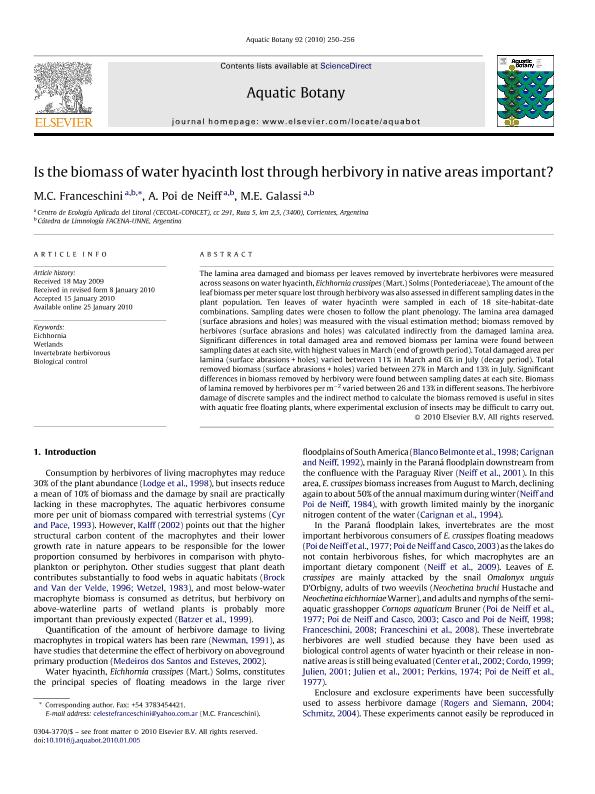Artículo
Is the biomass of waterhyacinth lost through herbivory in native areas important?
Fecha de publicación:
05/2010
Editorial:
Elsevier Science
Revista:
Aquatic Botany
ISSN:
0304-3770
Idioma:
Inglés
Tipo de recurso:
Artículo publicado
Clasificación temática:
Resumen
The lamina area damaged and biomass per leaves removed by invertebrate herbivores were measured across seasons on water hyacinth, Eichhornia crassipes (Mart.) Solms (Pontederiaceae). The amount of the leaf biomass permeter square lost through herbivory was also assessed in different sampling dates in the plant population. Ten leaves of water hyacinth were sampled in each of 18 site-habitat-date combinations. Sampling dates were chosen to follow the plant phenology. The lamina area damaged (surface abrasions and holes) was measured with the visual estimation method; biomass removed by herbivores (surface abrasions and holes) was calculated indirectly from the damaged lamina area. Significant differences in total damaged area and removed biomass per lamina were found between sampling dates at each site, with highest values in March (end of growth period). Total damaged area per lamina (surface abrasions + holes) varied between 11% in March and 6% in July (decay period). Total removed biomass (surface abrasions + holes) varied between 27% in March and 13% in July. Significant differences in biomass removed by herbivory were found between sampling dates at each site. Biomass of lamina removed by herbivores perm2 varied between 26 and 13% in different seasons. The herbivore damage of discrete samples and the indirect method to calculate the biomass removed is useful in sites with aquatic free floating plants, where experimental exclusion of insects may be difficult to carry out
Palabras clave:
Eichhornia
,
Wetlands
,
Invertebrate Herbivorous
,
Biological Control
Archivos asociados
Licencia
Identificadores
Colecciones
Articulos(CECOAL)
Articulos de CENTRO DE ECOLOGIA APLICADA DEL LITORAL (I)
Articulos de CENTRO DE ECOLOGIA APLICADA DEL LITORAL (I)
Citación
Franceschini, Maria Celeste; Poi, Alicia Susana G.; Galassi, María Eugenia; Is the biomass of waterhyacinth lost through herbivory in native areas important?; Elsevier Science; Aquatic Botany; 92; 4; 5-2010; 250-256
Compartir
Altmétricas




